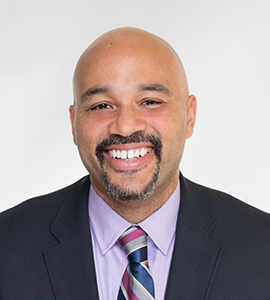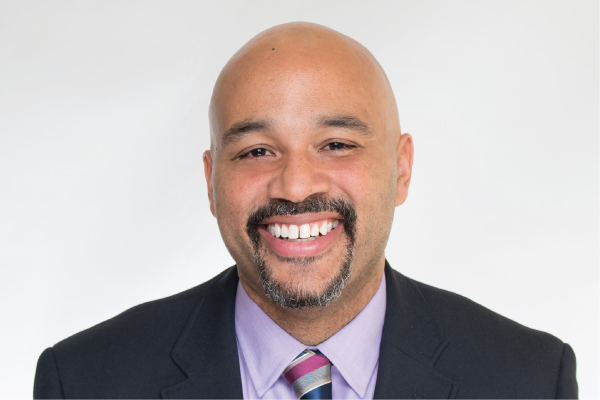Pascal Crosley, DO, was honored with the Dr. Wes Curry Emergency Medicine Diversity Leadership Award at Vituity’s 2019 Executive Leadership Diversity Summit.
Dr. Crosley is a vice president of practice development at Vituity and a practicing emergency physician. During his tenure as chairman of emergency services at Saint Agnes Hospital in Baltimore, he developed navigation programs to address underlying health conditions among poor and minority populations with frequent ED visits. Colleagues nominated Dr. Crosley for the Curry Award, noting that “his passion for mentorship has cultivated a long line of leaders who have gone on to pave their own notable careers.”
We recently sat down with Dr. Crosley to learn more about his commitment to diversity in healthcare.
I understand you’ve worked hard to improve the health of the Baltimore community. What’s your personal connection to this city?
Dr. Crosley: It would have to start with my dad, who was a practicing physician in the city of Baltimore for over 40 years. He was incredibly committed to the people here and a great role model of service, justice, and equity in healthcare.
I spent the early part of my medical career with Vituity in Atlanta, but I stayed in touch with the medical community back in Baltimore. While serving as ED medical director at DeKalb Medical Center, now part of Emory Healthcare, I got to know some hospital leaders from Saint Agnes. They really liked what Vituity had accomplished at DeKalb, which had a large, urban emergency department similar to their own.
Saint Agnes eventually asked Vituity to be its emergency medicine group and requested that I come on board as chairman of emergency services. That was an incredibly proud moment for me. A few months later, we packed up the car and headed north to Baltimore. And I’ve been here ever since.
What challenges did you face as the incoming emergency services chair?
Dr. Crosley: The Saint Agnes ED serves 70,000 patients a year, so it plays a huge role in supporting the health of the Baltimore community. But back in the early 2010s, the department was developing a reputation for crowding. To put things in perspective, most hospitals would be alarmed if more than 2% of ED patients got tired of waiting and left before seeing a provider. By contrast, the walkout rate when I arrived at Saint Agnes was 8%.
The department also faced staffing difficulties. Greater Baltimore is home to two emergency medicine residencies, but it had been years since Saint Agnes had recruited a resident from either of them.
How did you start to turn things around?
Dr. Crosley: I knew that in order to improve the culture of the department, we had to attract the right providers. And it was important to all involved—myself, Saint Agnes, and Vituity—to recruit locally. Baltimore is an incredibly diverse community, and we wanted our providers to relate to our patients and understand their needs.
Vituity's culture and democratic partnership model sold itself. Almost every ER physician referred to us joined up. In just one month, we were fully staffed with highly qualified physicians and advanced providers—most of whom were local and mirrored the rich diversity of our patients.
I understand that today the Saint Agnes ED is quite a success story.
Dr. Crosley: It didn’t happen overnight, and it was definitely a team effort. But just one year later, patients were moving so efficiently through the department that it actually felt quiet. By that time, our patient satisfaction scores had doubled, and the walkout rate had plummeted to 1.7%. We wondered if it was so “slow” because patients were actually going somewhere else for care. But when we looked at our numbers, ED volumes were up 10%. It was a powerful testament to our teamwork and the changes we’d put in place.
In your opinion, what are the most important steps EDs can take to combat health disparities?
Dr. Crosley:To me, healthcare is a right, not a privilege. All of the big cities I’ve worked in—Baltimore; New York; Atlanta; Washington, D.C.—have many poor neighborhoods. And health disparities tend to emulate socioeconomic disparities.
For example, many people in low-income communities like West Baltimore or Washington Highlands have very limited access to medical care outside the ED. They may be uninsured. Or they may not have the resources to afford deductibles and co-pays. And they may not have the luxury of taking time off from work to visit a doctor’s office.
It’s also true that social ills display themselves medically. For example, many poor urban neighborhoods are food deserts. It’s hard to manage your blood sugar when you have zero access to fresh fruits and vegetables. You do, however, have access to all the liquor stores and vape shops you need.
So if we really want to address health disparities for this population, we need to redefine the role of the ED. It’s imperative to move beyond a “treat and street” mindset and help patients address the social determinants of health.
Under your leadership, the Saint Agnes ED implemented a very successful navigation program for high-utilizers. Can you tell us about it?
Dr. Crosley: Every ED has “frequent flyers” who return day after day, month after month. Often these are medically complex patients who for whatever reason—poverty, housing instability, lack of coverage—have been unable to establish a medical home.
To better meet the needs of these patients, our front-line ED providers formed a care plan committee. They identified our highest utilizers and collaborated with providers across the hospital to compile comprehensive histories and recommendations. In order to improve continuity, we embedded these care plans into the hospital EHR and our regional HIE.
Reviewing utilization data gave us some surprising insights into this vulnerable population. For example, we learned that many of our most frequent utilizers were actually in their final months of life. We were then able to connect them with helpful end-of-life resources, like our hospice and palliative care teams.
The care plans made a huge difference for both patients and the hospital. One of the patients the committee supported had a chronic condition that was greatly exacerbated by his use of narcotics. His new care plan included interventions that more effectively managed his pain. As a result, he went from spending 250 days per year as an inpatient to zero.
Colleagues who nominated you for the Curry Award say you have mentored “a long line of leaders.” What motivates you to give back to so many?
Dr. Crosley: I’ve always had a passion for helping young people. Whether or not we like to admit it, none of us succeeds alone. We all go through our trials and tribulations in school, in residency, at work. So I think we have a responsibility to extend a helping hand to those who are following behind. Helping someone avoid the pitfalls I experienced brings a new dimension of satisfaction to my practice.
Do you have any recent success stories?
Dr. Crosley: A few years ago, one of the scribes in our department started asking me about medical school. He was a college graduate who was interested in medicine but had some reservations. We talked about postbaccalaureate programs as a way to strengthen his application. And I also shared my MCAT study plan, which I recommend to applicants who want to prepare for the test over 12 to 18 months.
This young man was eventually admitted to Temple University’s postbaccalaureate program, where he worked extremely hard. And based on that effort, he received a four-year scholarship to Temple’s school of medicine. We’ve kept in touch, and I really couldn’t be prouder of him.
Did you have a mentor who had a special impact on your career?
Dr. Crosley: I’m proud to say that Dr. Wes Curry was one. When I started working for Vituity back in 2005, black CEOs were rare in healthcare. And he wasn’t just some distant suit in a boardroom. He took a personal interest in my career and supported me as a medical director and ER physician executive. My practice, my career, and indeed my life are all richer for knowing him.























